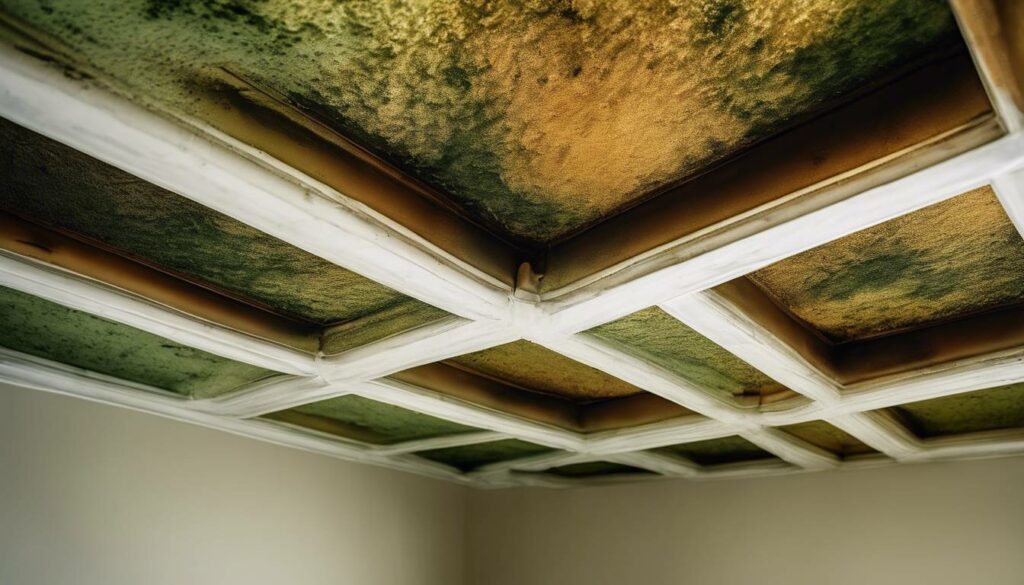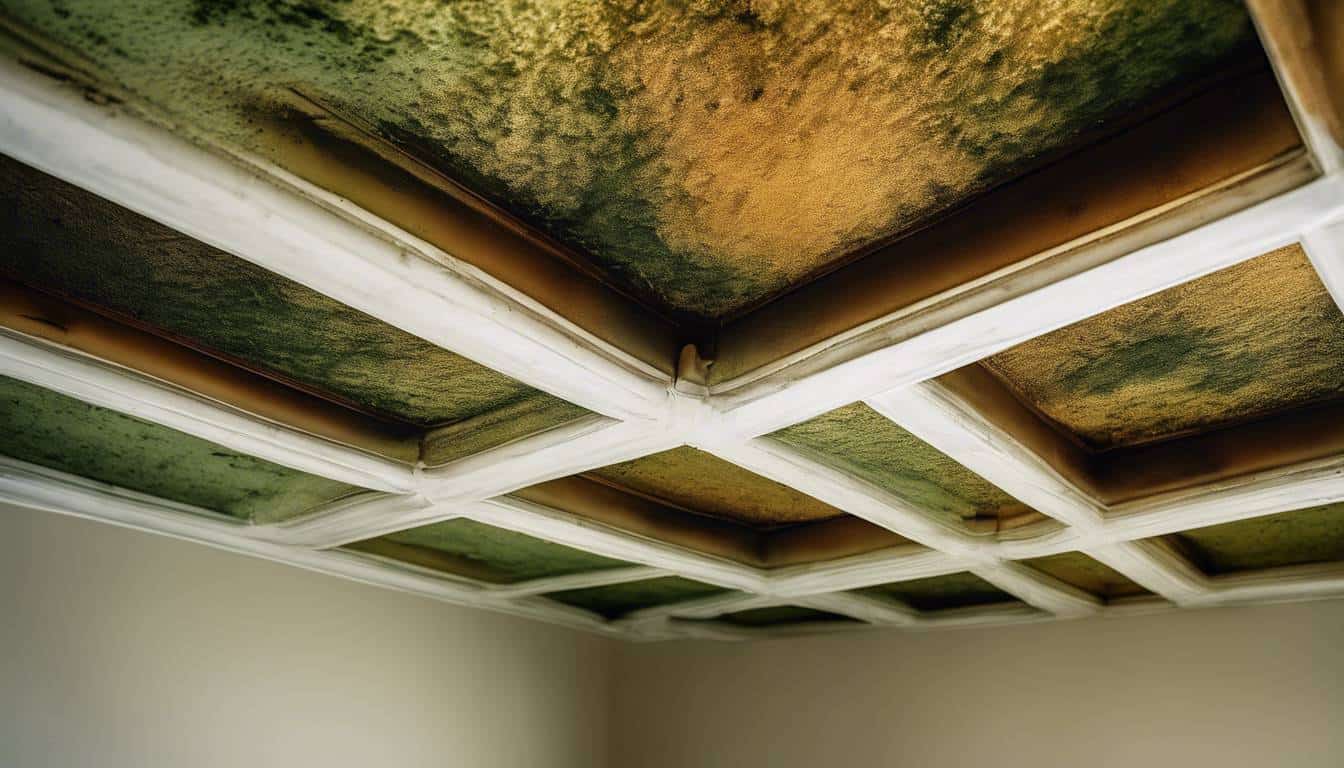Trust me, it can be HARD to identify hidden mold in a house. Identifying mold at home requires looking out for several things. Notable signs include a musty smell, water stains, or visible mold growth on walls and surfaces. On close inspection, peeling or bubbling paint and wallpaper could point towards moisture issues that favor the growth of mold. Even experiencing unexplained allergy symptoms could actually be due to an unseen mold issue.
But all molds aren’t alike. Depending on where your sink leaks or where steam condenses on your window, you may find fuzzy patches, black, green, or even orange discoloration – these are signs that mold is present.
Lastly, remember this- never underestimate a damp smell. When a room smells musty without any apparent reason, it’s time to start checking those hidden corners. Don’t wait till your family starts sneezing or coughing!
Identifying mold in your home can be done through visual inspection for signs of water damage or leaks, a musty smell, using moisture meters to check for high moisture levels, conducting indoor air quality tests, and tracking any health symptoms like allergies or respiratory issues. If you suspect mold, it’s important to consult with a professional mold inspector for accurate identification and next steps to address the issue.
Signs of Mold in Your Home
Detecting mold in your home can be tricky because it’s often hidden from plain sight. However, there are specific signs you can look out for, starting with the distinct musty smell. When you walk into a room and notice a peculiar odor, akin to dampness or earthiness, it might be a sign of mold lurking somewhere.
When examining your walls, ceilings, or floors, keep an eye out for water stains or any visible mold growth. Mold can appear in various hues: black, white, green, and orange, so be alert for any unusual discoloration. Additionally, peeling, bubbling, or discolored paint and wallpaper are often linked to moisture issues that contribute to mold growth. Over time, the persistent presence of moisture-laden environments will encourage mold spores to develop and spread.
Imagine this: You’re giving your ceiling a fresh coat of paint when suddenly you notice a peculiar dark patch looming overhead. It’s important not to dismiss such discolorations as regular wear and tear; these could very well be the early signs of mold growth demanding immediate attention before escalating into larger infestations.
Frequent allergy symptoms or respiratory issues among household members should also raise concerns about mold. Conditions such as sneezing, runny noses, congestion, skin rashes, and irritation to the eyes and throat are all suspected warning signals associated with mold exposure. If anyone in your household experiences these unexplained symptoms repetitively, it might be time to investigate further.
Consider any recent changes in health patterns. Have there been more frequent visits to the doctor due to persistent coughs or sinus infections? These could be indicative of exposure to mold spores.
Similarly, the EPA notes that exposure to mold can lead to nasal stuffiness, throat irritation, coughing, wheezing, and skin irritation. It’s important to connect these symptoms with potential environmental factors within your living space in order to ensure your family’s wellbeing.
By paying attention to these signs, you can detect and address mold problems before they escalate into larger issues that may affect both your home and health.
Identifying Visible Mold
When it comes to spotting visible mold in your home, it’s not always as obvious as you might think. Mold can grow in hidden, tucked-away spots, spreading quietly until it becomes a noticeable problem. To identify visible mold growth, pay close attention to surfaces that are prone to moisture, such as bathroom tiles and grout lines, kitchen sinks and counters, as well as basement walls and ceilings.
The sense of sight is key when looking for molds. Keep an eye out for fuzzy or velvety patches of mold on various surfaces. These can appear in a range of colors such as black, green, or orange. Sometimes the color might be more subtle, blending in with the surface it’s growing on.
But what about taking note of smells? Musty odors can be a telling sign of hidden molds lingering behind walls, tiles, or even within fabric upholstery. So if something doesn’t smell right in spaces like your basement or attic, there might be invisible mold quietly growing.
Let’s say you notice a damp smell in the corner behind your washing machine in the basement—something like old books left out in the rain. It might not be instantly obvious where that smell is coming from, as visible mold isn’t always present at the surface. But definitely worth investigating!
Checking areas near leaky pipes, windows, and roofs is also important because these are common spots for visible mold growth. When inspecting these areas, look for discoloration on surfaces – sometimes this can manifest as dark spots or staining. These locations are hotspots for mold due to the accumulation of moisture from water leaks.
Understanding how to identify visible mold empowers you to address potential issues before they become larger headaches. It guides you towards proactive measures to mitigate any future problems with mold.
Locating Hidden Mold
Hidden mold is a stealthy adversary. It enjoys lurking in the shadows, out of sight, making it a challenge to detect. It can thrive behind walls, above ceiling tiles, under carpets, and even inside air ducts. These concealed spots provide the ideal environment for mold growth—dark, damp, and undisturbed. So, how do we unveil this elusive foe? The key lies in diligence and thorough inspections.
One of the first things to consider is any past water damage or persistent moisture issues. These are prime breeding grounds for hidden mold. If you know there has been a leak or flooding in your home or notice lingering dampness in specific areas, these are red flags that warrant closer inspection.
Equipped with a good flashlight, you can peer into dark and concealed spaces to uncover hidden mold. Keep an eye (or nose) out for any musty odors as these can often signal the presence of hidden mold even before it becomes visible.
Also, pay attention to any allergy-like symptoms that worsen when spending time in a particular room or area. This could be a sign of hidden mold affecting your health.
For instance, Mary noticed that her son’s allergies seemed to worsen every time he played in the basement. This prompted her to inspect the area, and she discovered hidden mold growing on the drywall lurking behind some furniture.
It’s crucial to bear in mind that swift detection and remediation of hidden mold are crucial for maintaining a healthy living environment. Therefore, being observant of signs such as past water damage, musty odors, or unexplained health issues can help you stay ahead of potential hidden mold problems in your home.
Health Consequences of Mold Exposure
Mold growth in your home can significantly impact your health. This isn’t just about physical well-being; it extends to mental and emotional health too. Many associate mold-related health problems with nasal stuffiness, throat irritation, or aggravated coughing and wheezing. However, mold exposure can lead to severe respiratory issues such as asthma attacks and allergic reactions.
People with allergies, asthma, or weakened immune systems are particularly vulnerable to experiencing more serious responses to mold exposure. Mold spores in the air can be inhaled or come into contact with the skin, leading to an array of symptoms like skin rashes, redness, itchiness, and irritation. Prolonged exposure to mold can exacerbate existing respiratory conditions and lead to chronic issues like allergic rhinitis.
For instance, let’s consider someone who has asthma. When they breathe in mold spores, their immune system reacts strongly, causing inflammation in their airways. This can result in chest tightness, difficulty breathing, and even severe asthma attacks. Mold can still trigger respiratory problems over time for those without pre-existing conditions.
Moreover, beyond physical symptoms, exposure to mold can have mental and emotional repercussions. Persistent coughing and wheezing not only impact physical health but also affect psychological well-being, potentially leading to increased stress and anxiety due to ongoing discomfort and disruption of daily activities.
Research has found a direct correlation between mold exposure and adverse mental health effects such as mood swings and heightened stress levels. The constant presence of irritating symptoms can take a toll on an individual’s mental resilience over time.
It’s important to recognize that while some individuals may be more sensitive to mold than others, prolonged exposure can affect anyone regardless of their overall health status.
Understanding the far-reaching impact of mold exposure on both physical and mental health underscores the urgency of taking proactive measures to identify and eliminate mold in our living spaces.
Methods for Testing Mold Presence
When it comes to testing for mold, several methods are available, including home testing kits and professional mold inspection services.
Home Testing Kits
Home testing kits offer a convenient option for homeowners to gain insights into the presence of mold in their living environment. They are designed to be affordable, easy to use, and provide relatively quick results. These kits typically come with detailed instructions on how to collect samples from different areas in your home, such as walls, floors, or air vents. Once the samples are collected, they are sent to a laboratory for analysis, which will identify the types of molds present and their concentration levels.
It’s important to note that while home testing kits offer convenience and affordability, their accuracy may vary. Therefore, they may be more suitable for initial screening rather than definitive identification of mold types.
Professional Mold Inspection Services
For a more thorough evaluation and accurate identification of mold issues, especially in larger or hidden areas, professional mold inspection services are recommended. These services involve certified inspectors who have the expertise and tools to conduct a comprehensive assessment of your home for mold presence.
Professional inspections can include air sampling, surface sampling, and bulk sampling. Air sampling tests measure the concentration of mold spores in the air, providing insight into the overall air quality in your home. Surface sampling involves collecting samples from different surfaces to determine if mold is present and what types are present. Bulk sampling involves collecting physical material suspected of containing mold from areas such as walls or floors.
The cost of professional mold inspections can vary depending on the size of the property and the extent of testing required. While these services may entail a higher investment compared to home testing kits, they deliver a more comprehensive assessment by trained professionals, ensuring accurate identification of existing mold issues.
By exploring both home testing kits and professional mold inspection services, homeowners can make informed decisions about identifying and addressing mold concerns within their living spaces.
Understanding how to identify mold presence sets the stage for implementing effective strategies to prevent its growth and reduce its impact on your living environment.
Techniques for Mold Prevention and Reduction
Mold can be a sneaky intruder in our homes, often appearing in the most unexpected places. But there are ways to keep it at bay. Let’s delve into some effective techniques for preventing and reducing mold growth in your living space.
One of the key strategies is to control indoor humidity levels. Mold thrives in moist environments, so it’s crucial to keep humidity below 60% to discourage its growth. Using exhaust fans in bathrooms and kitchens can significantly reduce moisture buildup, preventing an ideal thriving environment for mold.
Regular inspection and repair of any leaks in plumbing, roofs, or windows are vital in preventing water intrusion that can lead to mold growth. Acting promptly to fix these issues is essential in maintaining a mold-free home environment.
Proper ventilation plays a significant role in reducing mold. Ensuring adequate airflow in moisture-prone areas like bathrooms and kitchens helps to keep these spaces dry and inhospitable to mold. Additionally, using dehumidifiers in areas prone to high humidity can effectively lower moisture levels, creating an environment that inhibits mold growth.
Imagine your bathroom after a hot shower. The steamy air lingers, settling on surfaces and creating an ideal environment for mold growth. Installing vent fans that pull this moist air out and away can help prevent this scenario.
Similarly, as fresh air helps clear our minds, ventilating our homes with fresh air clears out stagnant, moist air that encourages mold growth.
Using mold-resistant products such as paints and building materials in moisture-prone areas can provide an additional layer of protection against mold. These specialized products are designed to resist mold growth, contributing further to preventive efforts.
By implementing these techniques, you can significantly reduce the risk of mold growth in your home and create a healthier living environment for you and your family.
These practical strategies empower homeowners to take charge of their indoor environments and proactively combat the threat of mold. By staying informed and proactive, you can ensure a healthier and more comfortable living space.






